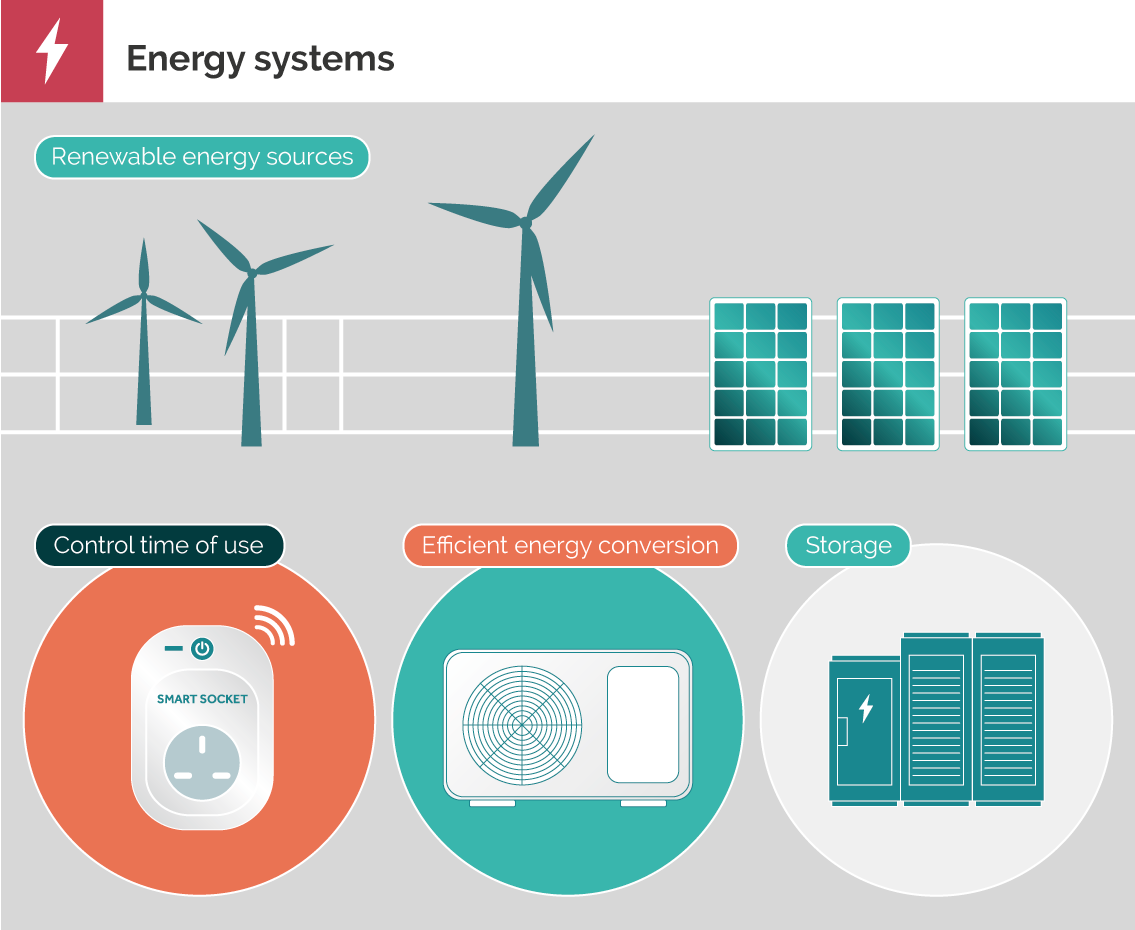
Energy use is strongly affected by the wider energy system and vice versa. Increased use of variable renewable energy sources and electrification to accommodate them will enable increased energy efficiency.
The transition to variable renewable energy sources will also increase the value of flexibility in electricity use. Energy use therefore needs to reduce, to become more flexible and to use decarbonised fuels.
Smaller, modular and mass-produced technologies tend to improve more quickly than large-scale, capital intensive and site-specific technologies such as nuclear power. The effect has been documented in solar photovoltaics, wind and battery storage, and is particularly important for end-use technologies such as lighting. There are no fundamental physical, land use or economic barriers to a transition from today’s fossil-fuelled energy system to one based on wind energy and solar photovoltaics. However, a prerequisite for such a global transition will be an almost complete reorganisation of the architecture of energy systems around the new cheaper sources of energy. This has profound implications for energy geopolitics and trade, with energy production shifting from regions with large fossil fuel reserves to those with good renewable resources [1].
Electrification also has implications for user practices and end-use technologies – it is not just an energy supply transition [2]. It implies a shift from energy sources that produce heat to ones that produce work, enabling very large improvements in the conversion efficiency of energy at the point of use, in particular through the use of heat pumps and electric vehicles. These lead to a reduction in final energy demand of up to 40% below a counterfactual with the current fuel mix, so the effect forms a major component of the potential for demand reduction, leading to a larger electricity system, but a much smaller, and therefore probably more secure, overall energy system [3].
Options for heat system decarbonisation have different infrastructure and energy system architecture implications. Evidence from expert stakeholder consultation [4] and modelling [5] suggests that electricity for building-scale heat pumps, hydrogen technologies and heat networks could all contribute. All would require substantial capital investment, although hydrogen could use the existing natural gas distribution infrastructure, which is otherwise likely to be a stranded asset. However, green hydrogen (from electrolysis) for use in boilers would require about four times more electricity than an electric heat pump for the same heat output. Blue hydrogen (from natural gas and using carbon capture and storage) has residual carbon dioxide emissions and would prolong dependence on natural gas. There is therefore a consensus that heat pumps, at sizes from domestic to utility scale, will play a key role in heat decarbonisation in most areas. However, policy, technical, supply chain, public acceptance and cost challenges need to be overcome to achieve rates of deployment consistent with UK targets [7], see Buildings and heating.
In most end uses, electricity will be the preferred future fuel. However, there are some end uses for which electrification is not feasible and others where the choice and/or balance between different zero-carbon fuels remains uncertain. In steelmaking, both hydrogen and electricity have a role [8], as well as downstream policies to reduce demand [9], see Industry and materials. In aviation and shipping, electricity, biofuels, hydrogen, ammonia and other synthetic fuels all remain options [10].
As the use of fossil fuels declines, new energy storage technologies will be needed to maintain energy system security. Decisions on heat decarbonisation may largely drive what forms of energy storage will be built. In high renewables systems, tens of TWh of long-duration storage will be needed [5, 6], far exceeding what can be provided by batteries, implying the use of chemical and/or thermal storage technologies, some of which are currently immature.
The likely scale and uncertainties in energy system change imply divergent possible end points, and point to the value of an overarching system architecture perspective [11]. Flexibility, resilience to shocks, and therefore diversity will be important considerations, not just cost [12]. Recent price shocks highlight the crucial importance of energy security. Demand side changes, both to reduce demand and increase flexibility of use, can play a key role in mitigation such shocks [13], see The energy security and affordability crisis, emphasising the importance of systems thinking in energy policy.
Evidence
- Solar, wind and logistic substitution in global energy supply to 2050 – Barriers and implications | Research paper, 2021
- Reaching a 1.5°C target: socio-technical challenges for a rapid transition to low-carbon electricity systems | Research paper, 2018
- From using heat to using work: reconceptualising the zero carbon energy transition | Research paper, 2021
- Eliciting stakeholders’ requirements of future energy systems: a case study of heat decarbonisation in the UK | Research paper, 2022
- Large-scale energy storageOpens in a new tab | Report, 2023
- Building decarbonisation transition pathways | CREDS Policy brief 013, 2020
- Energy system requirements of fossil-free steelmaking using hydrogen direct reduction | Research paper, 2021
- Technology and material efficiency scenarios for net-zero emissions in the UK steel sector | Research paper, 2022
- Evidence to the House of Commons Environmental Audit Committee inquiry into net-zero aviation and shipping | CREDS Consultation, 2021
- Heat decarbonisation modelling approaches in the UK: An energy system architecture perspective | Research paper, 2020
- Lost generation: Reflections on resilience and flexibility from an energy system architecture perspective | Research paper, 2021
- The energy price crisis – issues for energy use | CREDS Policy brief 023, 2022
Banner photo credit: Pat Whelen on Unsplash
